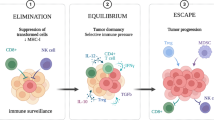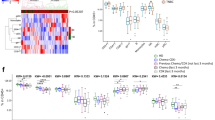Abstract
Background
Regulatory T cells (Tregs) play a major role in tumor escape from immunosurveillance by suppressing effector cells. The number of Tregs is increased in tumor sites and peripheral blood of breast cancer patients. However, the data regarding phenotypic and functional heterogeneity of Treg subpopulations in breast cancer are limited. The present study aimed to investigate the number and suppressive potential of Tregs that possess natural naïve-(N nTregs), effector/memory-like (EM nTregs), and Tr1-like phenotypes in breast cancer patients and healthy women.
Methods
The study included 10 HW and 17 primary breast cancer patients. Numbers of CD4+CD25+FoxP3+CD45RA+ N nTregs, CD4+CD25+FoxP3+CD45RA− EM nTregs, and CD4+IL-4−IL-10+ Tr1 subsets and the expression of CTLA-4, CD39, GITR, LAP, and IL-35 by these Treg subsets were measured in freshly obtained peripheral blood by flow cytometry.
Results
Herein, we demonstrate that the percentages of N nTregs, EM nTregs, CD25+ and FoxP3+ Tr1 cells are elevated in the peripheral blood of breast cancer patients, but do not correlate with cancer stages. Nevertheless, the frequency of CD25+ Tr1 cells was associated with nodal involvement, while the number of EM nTregs correlated with clinical outcome. The expression of CTLA-4 and IL-35 by all assessed Treg subsets was increased throughout all tumor stages (I–III).
Conclusions
Collectively, the current study shows phenotypic alterations in suppressive receptors of Treg subsets, suggesting that breast cancer patients have increased activity of N nTregs, EM nTregs and Tr1 cells; and EM nTregs and CD25+ Tr1 cells represent prospective markers for assessing disease prognosis.




Similar content being viewed by others
Abbreviations
- CTLA-4:
-
Cytotoxic T-lymphocyte antigen-4
- EM nTregs:
-
CD4+CD25+FoxP3+CD45RA− effector/memory-like T regulatory cells;
- GITR:
-
Glucocorticoid-induced tumor necrosis factor receptor
- iTregs:
-
Adaptive/induced T regulatory cells
- LAP:
-
Latency associated peptide
- nTregs:
-
Natural T regulatory cells
- N nTregs:
-
CD4+CD25+FoxP3+CD45RA+ naïve-like T regulatory cells
- TIL:
-
Tumor-infiltrating lymphocytes
- TNM:
-
Tumor/node/metastasis classification and staging system
- Tr1:
-
Type 1 T regulatory cells
- Tregs:
-
T regulatory cells
References
Stewart BW, Wild CP. World cancer report 2014. World Health Organ 2014:1–2
Zou W. Regulatory T, cells, tumour immunity and immunotherapy. Nat Rev Immunol. 2006;6(4):295–307. https://doi.org/10.1038/nri1806.
Shevach EM. Mechanisms of Foxp3+ T regulatory cell-mediated suppression. Immunity. 2009;30(5):636–45. https://doi.org/10.1016/j.immuni.2009.04.010.
Adeegbe DO, Nishikawa H. Natural and induced T regulatory cells in cancer. Front Immunol. 2013;4:190. https://doi.org/10.3389/fimmu.2013.00190.
Roncarolo MG, Bacchetta R, Bordignon C, Narula S, Levings MK. Type 1 T regulatory cells. Immunol Rev. 2001;182:68–79. https://doi.org/10.1034/j.1600-065X.2001.1820105.x.
Miyara M, Yoshioka Y, Kitoh A, Shima T, Wing K, Niwa A, et al. Functional delineation and differentiation dynamics of human CD4+ T cells expressing the FoxP3 transcription factor. Immunity. 2009;30(6):899–911. https://doi.org/10.1016/j.immuni.2009.03.019.
Booth NJ, McQuaid AJ, Sobande T, Kissane S, Agius E, Jackson SE, et al. Different proliferative potential and migratory characteristics of human CD4+ regulatory T cells that express either CD45RA or CD45RO. J Immunol. 2010;184(8):4317–26. https://doi.org/10.4049/jimmunol.0903781.
Watanabe MA, Oda JM, Amarante MK, Cesar Voltarelli J. Regulatory T cells and breast cancer: implications for immunopathogenesis. Cancer Metastasis Rev. 2010;29(4):569–79. https://doi.org/10.1007/s10555-010-9247-y.
Shimizu J, Yamazaki S, Sakaguchi S. Induction of tumor immunity by removing CD25+ CD4+ T cells: a common basis between tumor immunity and autoimmunity. J Immunol. 1999;163:5211–8.
Ladoire S, Arnould L, Apetoh L, Coudert B, Martin F, Chauffert B, et al. Pathologic complete response to neoadjuvant chemotherapy of breast carcinoma is associated with the disappearance of tumor-infiltrating FoxP3+ regulatory T cells. Clin Cancer Res. 2008;14(8):2413–20. https://doi.org/10.1158/1078-0432.CCR-07-4491.
Zhou Y, Shao N, Aierken N, Xie C, Ye R, Qian X, et al. Prognostic value of tumor-infiltrating Foxp3+ regulatory T cells in patients with breast cancer: a meta-analysis. J Cancer. 2017;8:4098–105. https://doi.org/10.7150/jca.21030.
Gol-Ara M, Jadidi-Niaragh F, Sadria R, Azizi G, Mirshafiey A. The role of different subsets of regulatory T cells in immunopathogenesis of rheumatoid arthritis. Arthritis. 2012;2012:805875. https://doi.org/10.1155/2012/805875.
Kotsakis A, Koinis F, Katsarou A, Gioulbasani M, Aggouraki D, Kentepozidis N, et al. Prognostic value of circulating regulatory T cell subsets in untreated non-small cell lung cancer patients. Sci Rep. 2016;6:39247. https://doi.org/10.1038/srep39247
Wolf AM, Wolf D, Steurer M, Gastl G, Gunsilius E, Grubeck-Loebenstein B. Increase of regulatory T cells in the peripheral blood of cancer patients. Clin Cancer Res. 2003;9(2):606–12. https://doi.org/10.1158/1078-0432.ccr-05-1244.
Chaudhary B, Elkord E. Regulatory T cells in the tumor microenvironment and cancer progression: role and therapeutic targeting. Vaccines (Basel). 2016;4(3):28. https://doi.org/10.3390/vaccines4030028.
Beyer M, Classen S, Endl E, Kochanek M, Weihrauch MR, Debey-Pascher S, et al. Comparative approach to define increased regulatory T cells in different cancer subtypes by combined assessment of CD127 and FoxP3. Clin Dev Immunol. 2011;2011:734036. https://doi.org/10.1155/2011/734036.
Abo-Elenein A, Elgohary SE, Hashish A, El-Halaby E. Significance of immunoregulatory T cells in different stages of breast cancer. Egypt J Immunol. 2008;15(2):145–52.
Liyanage UK, Moore TT, Joo H, Tanaka Y, Herrmann V, Doherty G, et al. Prevalence of regulatory T cells is increased in peripheral blood and tumor microenvironment of patients with pancreas or breast adenocarcinoma. J Immunol. 2002;169:2756–61. https://doi.org/10.4049/jimmunol.169.5.2756.
Tran DQ, Andersson J, Hardwick D, Bebris L, Illei GG, Shevach EM. Selective expression of latency-associated peptide (LAP) and IL-1 receptor type I/II (CD121a/CD121b) on activated human FOXP3+ regulatory T cells allows for their purification from expansion cultures. Blood. 2009;113(21):5125–33. https://doi.org/10.1182/blood-2009-01-199950.
Collison LW, Chaturvedi V, Henderson AL, Giacomin PR, Guy C, Bankoti J, et al. Interleukin-35-mediated induction of a novel regulatory T cell population. Nat Immunol. 2010;11(12):1093–101. https://doi.org/10.1038/ni.1952.
Mahalingam J, Lin C-Y, Chiang J-M, Su PJ, Chu YY, Lai HY, et al. CD4+ T cells expressing latency-associated peptide and Foxp3 are an activated subgroup of regulatory T cells enriched in patients with colorectal cancer. PLoS One. 2014;9(9):e108554. https://doi.org/10.1371/journal.pone.0108554.
Schuler PJ, Schilling B, Harasymczuk M, Hoffmann TK, Johnson J, Lang S, et al. Phenotypic and functional characteristics of CD4+ CD39+ FOXP3+ and CD4+ CD39+ FOXP3neg T-cell subsets in cancer patients. Eur J Immun. 2012;42(7):1876–85. https://doi.org/10.1002/eji.201142347.
Cai XY, Wang XF, Li J, Dong JN, Liu JQ, Li NP, et al. Overexpression of CD39 and high tumoral CD39+/CD8+ ratio are associated with adverse prognosis in resectable gastric cancer. Int J Clin Exp Pathol. 2015;8(11):14757–64.
Turnis ME, Sawant DV, Szymczak-Workman AL, Andrews LP, Delgoffe GM, Yano H, et al. Interleukin-35 limits anti-tumor immunity. Immunity. 2016;44(2):316–29. https://doi.org/10.1016/j.immuni.2016.01.013.
Syed Khaja AS, Toor SM, El Salhat H, Faour I, Ul Haq N, Ali BR, et al. Preferential accumulation of regulatory T cells with highly immunosuppressive characteristics in breast tumor microenvironment. Oncotarget. 2017;8(20):33159–71. https://doi.org/10.18632/oncotarget.16565.
Krausz LT, Fischer-Fodor E, Major ZZ, Fetica B. GITR-expressing regulatory T-cell subsets are increased in tumor-positive lymph nodes from advanced breast cancer as compared to tumor-negative lymph nodes. Int J Immunopathol Pharmacol. 2012;25(1):59–66. https://doi.org/10.1177/039463201202500108.
Perfilyeva Y, Ostapchuk Y, Aktas Cetin E, Yilmaz A, Deniz G, Talaeva S, et al. Hyaluronan-binding T regulatory cells in peripheral blood of breast cancer. Clin Cell Immunol. 2015;6(1):286. https://doi.org/10.4172/2155-9899.1000286.
Hamidinia M, Ghafourian Boroujerdnia M, Talaiezadeh A, Solgi G, Roshani R, Iranprast S, Khodadadi A. Increased P-35, EBI3 transcripts and other Tregs markers in peripheral blood mononuclear cells of breast cancer with different clinical stages. Adv Pharm Bull. 2015;5:261–267. https://doi.org/10.15171/apb.2015.036.
Gagliani N, Magnani CF, Huber S, Gianolini ME, Pala M, Licona-Limon P, et al. Coexpression of CD49b and LAG-3 identifies human and mouse T regulatory type 1 cells. Nat Med. 2013;19(6):739–46. https://doi.org/10.1038/nm.3179.
Bergmann C, Strauss L, Wang Y, Szczepanski MJ, Lang S, Johnson JT, et al. T regulatory type 1 cells in squamous cell carcinoma of the head and neck: mechanisms of suppression and expansion in advanced disease. Clin Cancer Res. 2008;14(12):3706–15. https://doi.org/10.1158/1078-0432.CCR-07-5126.
Cavani A, Nasorri F, Prezzi C, Sebastiani S, Albanesi C, Girolomoni G. Human CD4+ T lymphocytes with remarkable regulatory functions on dendritic cells and nickel-specific Th1 immune responses. J Invest Dermatol. 2000;114(2):295–302. https://doi.org/10.1046/j.1523-1747.2000.00881.x.
Chen J, Chen Z. The effect of immune microenvironment t on the progression and prognosis of colorectal cancer. Med Oncol. 2014;31:82. https://doi.org/10.1007/s12032-014-0082-9.
Adalid-Peralta L, Fragoso G, Fleury A, Sciutto E. Mechanisms underlying the induction of regulatory T cells and its relevance in the adaptive immune response in parasitic infections. Int J Biol Sci. 2011;7(9):1412–26. https://doi.org/10.7150/ijbs.7.1412.
Changkija B, Konwar R. Role of interleukin-10 in breast cancer. Breast Cancer Res Treat. 2012;133(1):11–21. https://doi.org/10.1007/s10549-011-1855-x.
Chen G, Liang Y, Guan X, Chen H, Liu Q, Lin B, et al. Circulating low IL-23: IL-35 cytokine ratio promotes progression associated with poor prognosis in breast cancer. Am J Transl Res. 2016;8(5):2255–64.
Ostapchuk YO, Cetin EA, Perfilyeva YV, Yilmaz A, Skiba YA, Chirkin AP, et al. Peripheral blood NK cells expressing HLA-G, IL-10 and TGF-β in healthy donors and breast cancer. Cell Immunol. 2015;298(1–2):37–46. https://doi.org/10.1016/j.cellimm.2015.09.002.
Deeb N, Mehanna RA. Assessment of maturation status of tumor-infiltrating dendritic cells in invasive ductal carcinoma of the breast: relation with vascular endothelial growth factor expression. Turk Patol Derg. 2013;29(3):193–200. https://doi.org/10.5146/tjpath.2013.01186.
Gregori S, Goudy KS, Roncarolo MG. The cellular and molecular mechanisms of immuno-suppression by human type 1 regulatory T cells. Front Immunol. 2012;3:30. https://doi.org/10.3389/fimmu.2012.00030.
Acknowledgements
This work was supported by the Grant AP05131691 “Molecular mechanisms of influence of T regulatory cells on tumor cell activity” of Science Committee of Ministry of education and science of the Republic of Kazakhstan.
Author information
Authors and Affiliations
Corresponding author
Ethics declarations
Conflict of interest
The authors declare that they have no competing interests.
About this article
Cite this article
Ostapchuk, Y.O., Perfilyeva, Y.V., Kustova, E.A. et al. Functional heterogeneity of circulating T regulatory cell subsets in breast cancer patients. Breast Cancer 25, 687–697 (2018). https://doi.org/10.1007/s12282-018-0874-4
Received:
Accepted:
Published:
Issue Date:
DOI: https://doi.org/10.1007/s12282-018-0874-4




